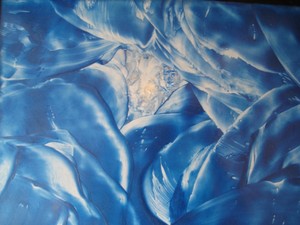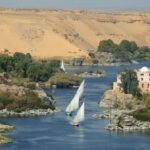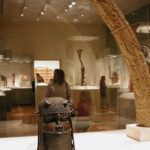Encaustic Wax Art History
Encaustic wax painting has been around since ancient Egyptian times, predating fresco and oil painting. The Egyptians painted with beeswax into which they added natural pigments. The result was beautiful paintings with a translucency not seen with oil painting or other mediums. The painting was mostly done in tombs and on funerary masks and many examples are still in existence ( If you live in New York City, you can see examples of ancient Encaustic casket portrait paintings at the Met Museum).
Current Status of Encaustic Painting
Encaustic wax painting came back into fashion centuries later and has in recent years gained a following. Many artists who do collage art dabble in Encaustic as the two work well together. Since wax paint is highly textured it can be a base for the collage objects or can be painted lightly over the entire work, sealing it and producing a shine. Wax paint can also be applied thickly to create more dimension. Contemporary Encaustic painting purists will paint only with beeswax paints and rarely will apply any varnish. The paintings are simply buffed with a soft cotton cloth and the result is a high shine and a vivid texture.
Tools
The tools used in wax painting can be as few as Encaustic beeswax paint squares, hardboard, various art knives and brushes, and an iron. The next level up in tools could include a hot air gun, a small torch or a hotplate. Some objects or accessories may be added to the paint such as sticker letters, flowers, cloth, photos or anything that works for the subject. Bases for the artwork include Encaustic board, wood board-usually made especially for wax paintings, hardboard and any other base that a creative artist can utilize. Unlike oil or water painting, Encaustic wax art is created on a table, not an easel, so a sturdy, large table is essential.
Homemade Wax Paints
Some Encaustic painters,including myself, find that creating one’s own wax paints is more authentic and desirable than using prepared wax paints. However, this is a bit of a process and since pure pigments are used it is necessary to be very careful when using potentially toxic pigments such as the metallic colors. Other than the pigments, beeswax and Damar resin are needed to create a strong, lasting paint. Pigments are added as needed to produce the desired colors, which requires a good knowledge of the color charts. These home made wax paints can be made in any quantity which is an advantage for the Encaustic painter.
Heat
Heat is the most important aspect of wax painting. A simple painting can be made by putting some wax paint shavings on sections of Encaustic paper and swirling a hot iron over the wax. The iron can be used to make abstract designs and is a good start for a wax art beginner. As the artist gains more experience in this art form design possibilities are unlimited. The wax painting can be heated from below on a hot plate and paint knives and brushes can be used to form designs or even portraits. Hot air guns can blast a small area giving the artist a chance to alter that one area or to create a textural effect.
The Encaustic Art Form
Encaustic wax painting art can be very satisfying and is often fascinating. One never knows what the final result will be and that creates somewhat of a mysterious nature to the art form. Controlling the medium is not at all the same as in oil, water or acrylic painting. This can cause frustration to artists who like to have a tight handle on the medium and the results. Encaustic art is more suitable for artists who value texture and color over precision. As a creative art form, Encaustic wax painting is interesting, challenging and above all provides a strong sense of accomplishment and pride.
Reference:
- The Art of Encaustic Painting by Joanne Mattera



